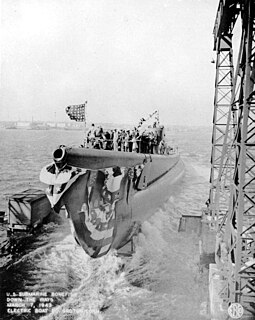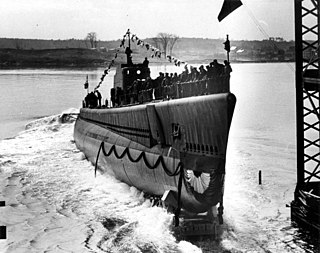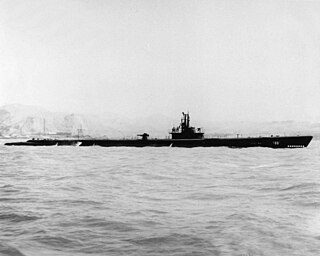
USS Skate (SS-305) was a Balao-class submarine in service with the United States Navy from 1943 to 1946. She was used as a target ship in the 1946 atomic bomb tests and finally sunk as a target ship in October 1948.

USS Bonefish (SS-223) was a Gato-class submarine, the first United States Navy ship to be named for the bonefish.

USS Stickleback (SS-415), a Balao-class submarine, was named for the stickleback, a small scaleless fish.

USS Tullibee (SS-284), a Gato-class submarine, was the first ship of the United States Navy to be named for the tullibee. Her keel was laid down on 1 April 1942 at Mare Island, California, by the Mare Island Navy Yard. She was launched on 11 November 1942 sponsored by Mrs. Kenneth C. Hurd; and commissioned on 15 February 1943, Commander Charles F. Brindupke in command.

USS Snapper (SS-185), a Salmon-class submarine, was the third ship of the United States Navy of the name and the second to be named for the snapper. Her keel was laid down by the Portsmouth Navy Yard on 23 July 1936. She was launched on 24 August 1937, sponsored by Mrs. Katharine R. Stark, wife of Rear Admiral Harold R. Stark, Chief of the Bureau of Ordnance, and commissioned on 16 December 1937 with Lieutenant F. O. Johnson in command.

USS Scabbardfish (SS-397), a Balao-class submarine, was the only ship of the United States Navy to be named for the scabbarddfish, a long, compressed, silver-colored fish found on European coasts and around New Zealand. In 1965 she was transferred to the Hellenic Navy and renamed Triaina.

USS Kingfish (SS-234), a Gato-class submarine, was the first ship of the United States Navy to be named for the kingfish.

USS Peto (SS-265), a Gato-class submarine, was a ship of the United States Navy named for the peto, a sharp-nosed tropical fish of the mackerel family.

USS Raton (SS/SSR/AGSS-270), a Gato-class submarine, was a ship of the United States Navy named for the raton, a polynemoid fish inhabiting semitropical waters off the Pacific coast of America.

USS Steelhead (SS-280), a Gato-class submarine, was a ship of the United States Navy named for the steelhead, a North American trout found from California to Alaska.

USS Sunfish (SS-281), a Gato-class submarine, was the first ship of the United States Navy to be named for the ocean sunfish, Mola mola, a plectognath marine fish, having a deep body truncated behind, and high dorsal and anal fins.

The first USS Trepang (SS/AGSS-412) was a Balao-class submarine in the United States Navy. She was named for the trepang, a marine animal sometimes called a 'sea slug' or a 'sea cucumber', having a long, tough, muscular body and found in the coral reefs of the East Indies.

USS Seahorse (SS-304), a Balao-class submarine, was the first submarine and second ship of the United States Navy to be named for the seahorse, a small fish whose head and the fore part of its body suggest the head and neck of a horse.

USS Sterlet (SS-392), a Balao-class submarine, was the only ship of the United States Navy to be named for the sterlet, a small sturgeon found in the Caspian Sea and its rivers, whose meat is considered delicious and whose eggs are one of the world's great delicacies, caviar.

USS Boarfish (SS-327), a Balao-class submarine, was a ship of the United States Navy named for the boarfish, a fish having a projecting hog-like snout.
The first USS Parche (SS-384/AGSS-384) was a United States Navy submarine. She bore the name of a butterfly fish, Chaetodon capistratus.

USS Spadefish (SS/AGSS-411), a Balao-class submarine, was the first ship of the United States Navy to be named for the spadefish. Although she was commissioned late in the war and spent only one year in the Pacific war zone, she was able to run up a record of 88,091 tons in 21 ships and numerous trawlers sunk.

USS Segundo (SS-398) was a Balao-class submarine, of the United States Navy named for the segundo, a cavalla fish of Caribbean waters.

USS Spikefish (SS/AGSS-404), a Balao-class submarine, was a ship of the United States Navy, named for the spikefish. She was the first United States submarine to record 10,000 dives.

USS Spot (SS-413) was a Balao-class submarine of the United States Navy, named for the spot, a small sciaenoid food fish of the Atlantic coast, with a black spot behind its shoulders.





















